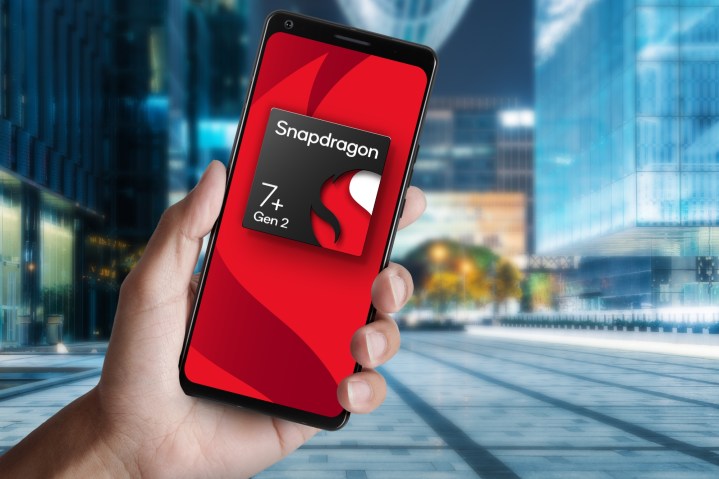Qualcomm has taken the wraps off its Snapdragon 7+ Gen 2, the next generation of its midrange mobile platform. The new chip is designed to deliver powerful entertainment experiences and performance gains to a broader range of smartphones.
The new platform is an evolution of last year’s Snapdragon 7 Gen 1, which was already a leap beyond the older Snapdragon 700 series it replaced. It began closing the gap with the premium Snapdragon 8 Gen 1 — a trend that continues with this year’s Snapdragon 7+ Gen 2.

In a confusing twist, Qualcomm has deliberately skipped the plain “non-plus” Snapdragon 7 Gen 2 to emphasize how much of a leap forward its latest midrange chip is. That might fit in better if a Snapdragon 8+ Gen 2 shows up later this year, but it feels a bit odd at this point.
Awkward naming aside, the Snapdragon 7+ Gen 2 packs a mighty big punch, so let’s dig in and see what’s new.
Why the Snapdragon 7+ Gen 2 Is Important
Although it’s built from the same 4-nanometer (4nm) process as last year’s chip, the Snapdragon 7+ Gen 2 delivers performance and optimizations previously only available on the more expensive Snapdragon 8-series chips.
This includes Qualcomm’s Kryo CPU that delivers 50% more performance, with peak speeds of up to 2.91GHz, and the Qualcomm Adreno GPU, which doubles the graphic performance. Even with these gains, Qualcomm has managed to improve power efficiency by 13% and integrate on-device AI across the entire platform. The integrated Qualcomm AI Engine has also doubled in performance while increasing power efficiency.

In practical terms, the Snapdragon 7+ Gen 2 will power better gaming experiences, improve image capture, and support faster Wi-Fi and 5G connectivity.
For gaming and entertainment fans, this includes support for Snapdragon Elite Gaming features like Auto Variable Rate Shading, Volumetric Rendering, and Snapdragon Sound with Qualcomm aptX lossless music streaming to deliver full-resolution content, more realistic graphics, and great audio.
The Snapdragon 7+ Gen 2 also features an 18-bit Triple Image Signal Processor (ISP) that promises to improve smartphone photography features with better lowlight performance and extreme dynamic range. The chip can handle resolutions of up to 200 megapixels and 4K high dynamic range (HDR) video capture with triple exposure from two cameras simultaneously.
The Snapdragon X62 5G Modem-RF system inside the Snapdragon 7+ Gen 2 can handle download speeds of up to 4.4Gbps, and also brings 5G/4G Dual-Sim Dual Active standby to the Snapdragon 7-series chips for the first time.
“Snapdragon is synonymous with premium mobile experiences. Today’s launch of the Snapdragon 7+ Gen 2 illustrates our ability to bring some of the most in-demand flagship features to our Snapdragon-7 series—making them accessible to more people,” Christopher Patrick, Qualcomm’s senior vice president and general manager of mobile handsets, said in the company’s press release.
While the Snapdragon 8 Gen 2 and its successors will continue to power premium flagship phones like the Samsung Galaxy S23 Ultra and OnePlus 11, the Snapdragon 7+ Gen 2 will bring more of the same entertainment, AI, and photographic capabilities to a new class of midtier smartphones.
Qualcomm says we can expect the first devices with the new chip to appear later this month, likely in phones costing around $400 to $600.


